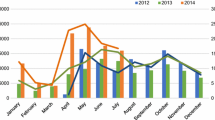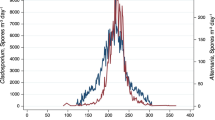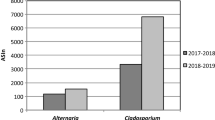Abstract
This study determined the relationship between airborne concentration of Cladosporium spp. spores and wind speed and direction using real data (local wind measured by weather station) and modelled data (air mass flow computed with the aid of HYbrid Single Particle Lagrangian Trajectory model). Air samples containing fungal conidia were taken at an urban site (Worcester, UK) for a period of five consecutive years using a spore trap of the Hirst design. A threshold of ≥6000 s m−3 (double the clinical value) was applied in order to select high spore concentration days, when airborne transport of conidia at a regional scale was more likely to occur. Collected data were then examined using geospatial and statistical tools, including circular statistics. Obtained results showed that the greatest numbers of spore concentrations were detected in July and August, when C. herbarum, C. cladosporioides and C. macrocarpum sporulate. The circular correlation test was found to be more sensitive than Spearman’s rank test. The dominance of either local wind or the air mass on Cladosporium spore distributions varied between examined months. Source areas of this pathogen had an origin within the UK territory. Very high daily mean concentrations of Cladosporium spores were observed when daily mean local wind speed was v s ≤ 2.5 m s−1 indicating warm days with a light breeze.




Similar content being viewed by others
References
Bensch, K., Braun, U., Groenewald, J. Z., & Crous, P. W. (2012). The genus Cladosporium. Studies in Mycology, 72, 1–401.
Bouziane, H., Latge, J. P., Fitting, C., Mecheri, S., Lelong, M., & David, B. (2005). Comparison of the allergenic potency of spores and mycelium of Cladosporium. Allergologia et Immunopathologia, 33, 125–130.
Bouziane, H., Latge, J. P., & Lelong, M. (2006). Immunochemical comparison of the allergenic potency of spores and mycelium of C. cladosporioides extracts by a nitrocellulose electroblotting technique. Allergologia et Immunopathologia, 34, 64–69.
CALPUFF Modeling System (1990) atmospheric studies group (ASG), http://www.src.com/calpuff/calpuff1.htm. Accessed March 3, 2017.
Calvo Torras, M. A., Guarro Artigas, J., & Suarez Fernandez, G. (1981). Air-borne fungi in the air of Barcelona (Spain). 4. Mycopathologia, 74, 19–24.
Díez Herrero, A., Sabariego Ruiz, S., Gutíerrez Bustillo, M., & Cervigón Morales, P. (2006). Study of airborne fungal spores in Madrid, Spain. Aerobiologia, 22, 135–142.
Draxler, R. R., & Rolph, G. D. (2014) HYSPLIT (HYbrid Single-Particle Lagrangian Integrated Trajectory) Model. NOAA Air Resources Laboratory. http://ready.arl.noaa.gov/HYSPLIT.php.
Ellis, M. B. (1971). Dematiaceous hyphomycetes. London: The Eastern Press Ltd.
Erkara, I. P., Ilhan, S., & Oner, S. (2009). Monitoring and assessment of airborne Cladosporium Link and Alternaria Nees spores in Sivrihisar (Eskisehir), Turkey. Environmental Monitoring and Assessment, 48, 477–484.
Fernández-Rodríguez, S., Sadyś, M., Smith, M., Tormo-Molina, R., Skjøth, C. A., Maya-Manzano, J. M., et al. (2015). Potential sources of airborne Alternaria spp. spores in south-west Spain. Science of the Total Environment, 533, 165–176.
Frankland, A. W., & Davies, R. R. (1965). Allergy to mold spores in England. Poumon et la Coeur, 21, 11–31.
Fulton, J. D. (1966). Microorganisms in the upper atmosphere. 3. Relationship between altitude and micropopulation. Journal of Applied Microbiology, 14, 237–240.
Green, B. J., Mitakakis, T. Z., & Tovey, E. R. (2003). Allergen detection from 11 fungal species before and after germination. Journal of Allergy and Clinical Immunology, 11, 285–289.
Grinn-Gofroń, A. (2008). The variation in spore concentrations of selected fungal taxa associated with weather conditions in Szczecin, Poland, 2004–2006. Grana, 47, 139–146.
Grinn-Gofroń, A. (2009). The occurrence of Cladosporium spores in the air and their relationships with meteorological parameters. Acta Agrobotanica, 62, 111–116.
Grinn-Gofroń, A., Sadyś, M., Kaczmarek, J., Bednarz, A., Pawłowska, S., & Jedryczka, M. (2016). Back-trajectory modelling and DNA-based species-specific detection methods allow tracking of fungal spore transport in air masses. Science of the Total Environment, 571, 658–669.
Harvey, R. (1967). Air-spora studies at cardiff. Transactions of the British Mycological Society, 50, 479–480.
Harvey, R. (1970). Spore productivity in Cladosporium. Mycopathologia et Mycologia Applicata, 41, 251–256.
Heinzerling, L., Frew, A. J., Bindslev-Jensen, C., Bonini, S., Bousquet, J., Bresciani, M., et al. (2005). Standard skin prick testing and sensitization to inhalant allergens across Europe—A survey from the GALEN network. Allergy, 60, 1287–1300.
Hernández-Ceballos, M. A., Skjøth, C. A., García-Mozo, H., Bolívar, J. P., & Galán, C. (2014). Improvement in the accuracy of back trajectories using WRF to identify pollen sources in southern Iberian Peninsula. International Journal of Biometeorology, 58, 2031–2043.
Herrero, B., & Zaldivar, P. (1997). Effects of meteorological factors on the levels of Alternaria and Cladosporium spores in the atmosphere of Palencia, 1990–1992. Grana, 36, 180–184.
Hirst, J. M. (1952). An automatic volumetric spore trap. Annals of Applied Biology, 39, 257–265.
Hirst, J. M. (1973). Spore transport and vertical profiles (Vol. 18). Bulletins from the Ecological Research Committee.
Hirst, J. M., Stedman, O. J., & Hurst, G. W. (1967). Long-distance spore transport—Vertical sections of spore clouds over sea. Microbiology, 48, 357–358.
Hjelmroos, M. (1993). Relationship between airborne fungal spore presence and weather variables—Cladosporium and Alternaria. Grana, 32, 40–47.
Hyde, H. A., Richards, M., & Williams, D. A. (1956). Allergy to mould spores in Britain. British Medical Journal, 1, 886–890.
Isard, S. A., Gage, S. H., Comtois, P., & Russo, J. M. (2005). Principles of the atmospheric pathway for invasive species applied to soybean rust. BioScience, 55, 851–861.
Kasprzyk, I., & Worek, M. (2006). Airborne fungal spores in urban and rural environments in poland. Aerobiologia, 22, 169–176.
Katial, R. K., Zhang, Y. M., Jones, R. H., & Dyer, P. D. (1997). Atmospheric mold spore counts in relation to meteorological parameters. International Journal of Biometeorology, 41, 17–22.
Kurkela, T. (1997). The number of Cladosporium conidia in the air in different weather conditions. Grana, 36, 54–61.
Lacey, J. (1981). The aerobiology of conidial fungi. In G. T. Cole (Ed.), Biology of conidial fungi (pp. 373–416). New York: Academic Press.
Lacey, M. E., & West, J. S. (2006). Air spora: A manual for catching and identifying airborne biological particles. Berlin: Springer.
Maya-Manzano, J. M., Sadyś, M., Tormo-Molina, R., Fernández-Rodríguez, S., Oteros, J., Silva-Palacios, I., et al. (2017). Relationships between airborne pollen grains, wind direction and land cover using GIS and circular statistics. Science of the Total Environment, 584–585, 603–613.
Mediavilla Molina, A., Angulo Romero, J., García-Pantaleón, F. I., Comtois, P., & Domínguez Vilches, E. (1998). Preliminary statistical modelling of the presence of two conidial types of Cladosporium in the atmosphere of Córdoba, Spain. Aerobiologia, 14, 229–234.
Mitakakis, T. Z., Kok Ong, E., Stevens, A., Guest, D., & Knox, R. B. (1997). Incidence of Cladosporium, Alternaria and total fungal spores in the atmosphere of Melbourne (Australia) over three years. Aerobiologia, 13, 83–90.
Morrow Brown, H., & Jackson, F. A. (1978a). Aerobiological studies based in Derby. 2. Simultaneous pollen and spore sampling at eight sites within a 60 km radius. Clinical Allergy, 8, 599–609.
Morrow Brown, H., & Jackson, F. A. (1978b). Aerobiological studies based in Derby. 3. Comparison of simultaneous pollen and spore counts from East coast, Midlands and West coast of England and Wales. Clinical Allergy, 8, 611–619.
Mukaka, M. M. (2012). A guide to appropriate use of correlation coefficient in medical research. Malawi Medical Journal, 24, 69–71.
Oliveira, M., Ribeiro, H., Delgado, J. L., & Abreu, I. (2009a). The effects of meteorological factors on airborne fungal spore concentration in two areas differing in urbanisation level. International Journal of Biometeorology, 53, 61–73.
Oliveira, M., Ribeiro, H., Delgado, J. L., & Abreu, I. (2009b). Seasonal and intradiurnal variation of allergenic fungal spores in urban and rural areas of the North of Portugal. Aerobiologia, 25, 85–98.
Ranta, H., & Pessi, A.-M. (2006). Pollen bulletin summary 2005. The Finnish Pollen Bulletin, 30, 1–12.
Rapiejko, P., Lipiec, A., Wojadas, A., & Jurkiewicz, D. (2004). Threshold pollen concentration necessary to evoke allergic symptoms. International Review of Allergology and Clinical Immunology, 10, 91–94.
Recio, M., del Mar Trigo, M., Docampo, S., Melgar, M., Garcia-Sanchez, J., Bootello, L., et al. (2012). Analysis of the predicting variables for daily and weekly fluctuations of two airborne fungal spores: Alternaria and Cladosporium. International Journal of Biometeorology, 56, 983–991.
Reynolds, A. M., Bohan, D. A., & Bell, J. R. (2007). Ballooning dispersal in arthropod taxa: conditions at take-off. Biology Letters, 3, 237–240.
Rodríguez-Rajo, F. J., Iglesias, I., & Jato, V. (2005). Variation assessment of airborne Alternaria and Cladosporium spores at different bioclimatical conditions. Mycological Research, 109, 497–507.
Rolph, G. D. (2014) Real-time Environmental Applications and Display sYstem (READY). NOAA Air Resources Laboratory. http://ready.arl.noaa.gov.
Sadyś, M., Adams-Groom, B., Herbert, R. J., & Kennedy, R. (2016). Comparisons of fungal spore distributions using air sampling at Worcester, England (2006–2010). Aerobiologia, 32, 619–634.
Sadyś, M., Kennedy, R., & Skjøth, C. A. (2015a). Determination of Alternaria spp. habitats using 7-day volumetric spore trap, Hybrid Single Particle Lagrangian Integrated Trajectory model and geographic information system. Urban Climate, 14, 429–440.
Sadyś, M., Kennedy, R., & Skjøth, C. A. (2015b). An analysis of local wind and air mass directions and their impact on Cladosporium distribution using HYSPLIT and circular statistics. Fungal Ecology, 18, 56–66.
Sadyś, M., Strzelczak, A., Grinn-Gofroń, A., & Kennedy, R. (2015c). Application of redundancy analysis for aerobiological data. International Journal of Biometeorology, 59, 25–36.
Sánchez Reyes, E., Rodríguez de la Cruz, D., Sanchís Merino, M. E., & Sánchez, J. (2009). Meteorological and agricultural effects on airborne Alternaria and Cladosporium spores and clinical aspects in Valladolid (Spain). Annals of Agricultural and Environmental Medicine, 16, 53–61.
Skjøth, C. A., Sommer, J., Frederiksen, L., & Karlson, U. G. (2012). Crop harvest in Denmark and central Europe contributes to the local load of airborne Alternaria spore concentrations in Copenhagen. Atmospheric Chemistry and Physics, 12, 11107–11123.
Smith, D. J., Jaffe, D. A., Birmele, M. N., Griffin, D. W., Schuerger, A. C., Hee, J., et al. (2012). Free tropospheric transport of microorganisms from Asia to North America. Microbial Ecology, 64, 973–985.
Sofiev, M., & Siljamo, P. (2004). Forward and inverse simulations with Finnish emergency model SILAM. In C. Borrego & S. Incecik (Eds.), Air pollution modelling and its applications (pp. 417–425). New York: Springer.
Sofiev, M., Siljamo, P., Valkama, I., Ilvonen, M., & Kukkonen, J. (2006). A dispersion modelling system SILAM and its evaluation against ETEX data. Atmospheric Environment, 40, 674–685.
Stępalska, D., & Wołek, J. (2005). Variation in fungal spore concentrations of selected taxa associated to weather conditions in Cracow, Poland, in 1997. Aerobiologia, 21, 43–52.
Troutt, C., & Levetin, E. (2001). Correlation of spring spore concentrations and meteorological conditions in Tulsa, Oklahoma. International Journal of Biometeorology, 45, 64–74.
Wu, P. C., Tsai, J. C., Li, F. C., Lung, S. C., & Su, H. J. (2004). Increased levels of ambient fungal spores in Taiwan are associated with dust events from China. Atmospheric Environment, 38, 4879–4886.
Zureik, M., Neukirch, C., Leynaert, B., Liard, R., Bousquet, J., & Neukirch, F. (2002). Sensitisation to airborne moulds and severity of asthma: cross sectional study from European community respiratory health survey. BMJ, 325, 1–7.
Acknowledgements
This project was funded by the University of Worcester and conducted within the framework of the doctoral studies. The author would like to thank Dr. Andrew M. Reynolds (Rothamsted Research) for a critical evaluation of the manuscript. Subsequently, thanks go to Dr. Carsten Ambelas Skjøth (University of Worcester) for producing Fig. 2 used in this study. Finally, the author would like to acknowledge the NOAA ARL for the provision of the HYSPLIT model used in this publication as well as access to input data (GDAS archive) for running the HYSPLIT model.
Author information
Authors and Affiliations
Corresponding author
Electronic supplementary material
Below is the link to the electronic supplementary material.
Rights and permissions
About this article
Cite this article
Sadyś, M. Effects of wind speed and direction on monthly fluctuations of Cladosporium conidia concentration in the air. Aerobiologia 33, 445–456 (2017). https://doi.org/10.1007/s10453-017-9482-6
Received:
Accepted:
Published:
Issue Date:
DOI: https://doi.org/10.1007/s10453-017-9482-6




